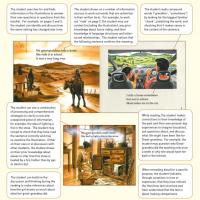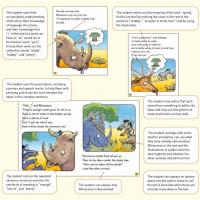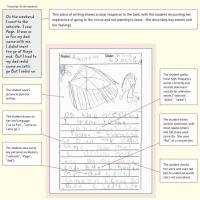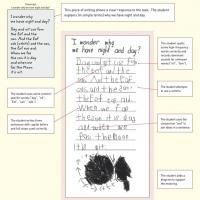After one year at school
The reading standard
The writing standard
The reading standard
After one year at school, students will read, respond to, and think critically about fiction and non-fiction texts at the green level of Ready to Read (the core instructional series that supports reading in The New Zealand Curriculum).
Key characteristics of texts at green level
Texts at green level have been designed with characteristics that include:
- generally familiar contexts and settings
- one text form, and one main storyline or topic, for each text
- most content explicitly stated but also some implicit content that provides opportunities for students to make simple inferences
- illustrations that support and extend the meaning but may not exactly match the words
- many high-frequency words
- topic words and interest words (including a wide range of regular and irregular verbs and some adjectives and adverbs) that are likely to be in a reader's oral vocabulary and that are strongly supported by the context or illustrations
- some visual language features such as diagrams or speech bubbles
- sentences that run over more than one line but do not split phrases
- dialogue between easily identified speakers
- a range of punctuation, including speech marks and commas, to support phrasing and meaning.
These characteristics support the development of reading behaviours that are illustrated here.
Illustrating the reading standard
The Way it Was by Dot Meharry; illustrated by Spike Wademan
This text is levelled at Green 1.
In this non-fiction text, a young girl compares her life with that of her great-grandma. The illustrations expand on the information given in the written text.
The text follows a 'then/now' pattern, with the narrator stating what is the same for her and her great-grandma and what is different. The time difference is reinforced by the use of colour (sepia for the past and full colour for the present day) and by the use of content-specific vocabulary, such as 'great-grandma', 'fire', and 'stove'.
This example highlights the sorts of reading behaviours teachers could expect to observe in students who are meeting the standard. Sometimes these behaviours will be in response to teacher prompts and questions, and sometimes they will be spontaneous as the students notice and respond to the ideas in the text. These behaviours may be during the first or subsequent readings and discussion.
A Good Idea by Bill Nagelkerke; illustrated by Jeffy James
This text is levelled at Green 3.
This humorous narrative is about four animals who want to find some relief from the blazing African sun. The setting may be outside the direct experience of most students, but it is likely to link to their indirect experience of Africa through television, movies, and video.
The text has a repetitive, cumulative structure, and much of the story is conveyed through dialogue. The illustrations and other visual language features, such as thought bubbles, speech bubbles, and the use of colour (yellow for heat and blue for shade) support the meaning and add to the humour.
Because A Good Idea is available as a big book as well as a small book, students are likely to have been introduced to it within a shared reading lesson.
The story’s theme is the importance of thinking and co-operation to solve problems.
This example highlights the sorts of reading behaviours teachers could expect to observe in students who are meeting the standard. Sometimes these behaviours will be in response to teacher prompts and questions, and sometimes they will be spontaneous as the students notice and respond to the ideas in the text. These behaviours may be during the first or subsequent readings and discussion.
Return to top
The writing standard
After one year at school, students will create texts as they learn in a range of contexts across the New Zealand Curriculum within level 1. Students will use their writing to think about, record, and communicate experiences, ideas, and information to meet specific learning purposes across the curriculum.
Key characteristics of students' writing at this level
Students will plan for writing, using talk or pictures. They will independently write simple texts, drawing on the knowledge, skills, and attitudes that will help them achieve their purpose. The knowledge, skills, and attitudes expected at this level, including those needed for spelling and punctuation, are described in the Literacy Learning Progressions.
The texts that students write will include, when appropriate:
- an idea, response, opinion, or question
- several sentences (including some compound sentences with simple conjunctions such as 'and')
- some key personal vocabulary and high-frequency words
- attempts at transferring words encountered in the writer's oral language or reading to their writing.
Illustrating the writing standard
On the weekend
The task exemplifies the writing demands of the English curriculum within level 1.
The students have been writing independently about their favourite holiday activity. They have been asked to plan, write, and then check their work.
This is the student’s first draft. Features of the writing that demonstrate the standard are described below.
This example illustrates the sorts of writing that teachers can expect of students who are meeting the standard. To meet the standard, students draw on the knowledge, skills, and attitudes for writing described in the Literacy Learning Progressions for students at this level.
I wonder why we have night and day?
The task exemplifies the writing demands of the English and science curriculum learning areas within level 1.
The students have been asked to write an explanation to answer the question 'I wonder why we have night and day?' The teacher has supported the students in this task by having them practise giving oral explanations on a familiar topic and by building their understanding of the topic through a variety of practical activities. The teacher has also provided appropriate reference materials and has explicitly taught relevant vocabulary.
This example illustrates the sorts of writing that teachers can expect of students who are meeting the standard. To meet the standard, students draw on the knowledge, skills, and attitudes for writing described in the Literacy Learning Progressions for students at this level.
Published on: 19 Oct 2009
Return to top





